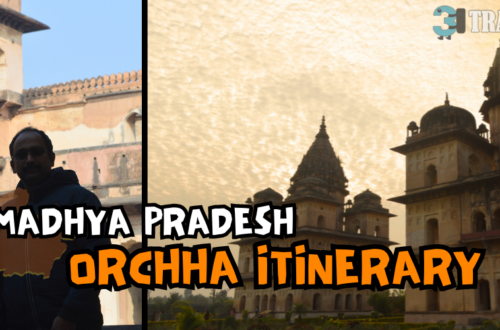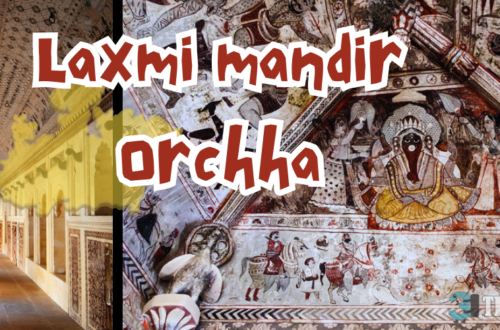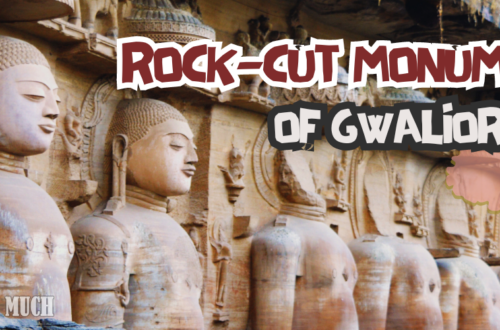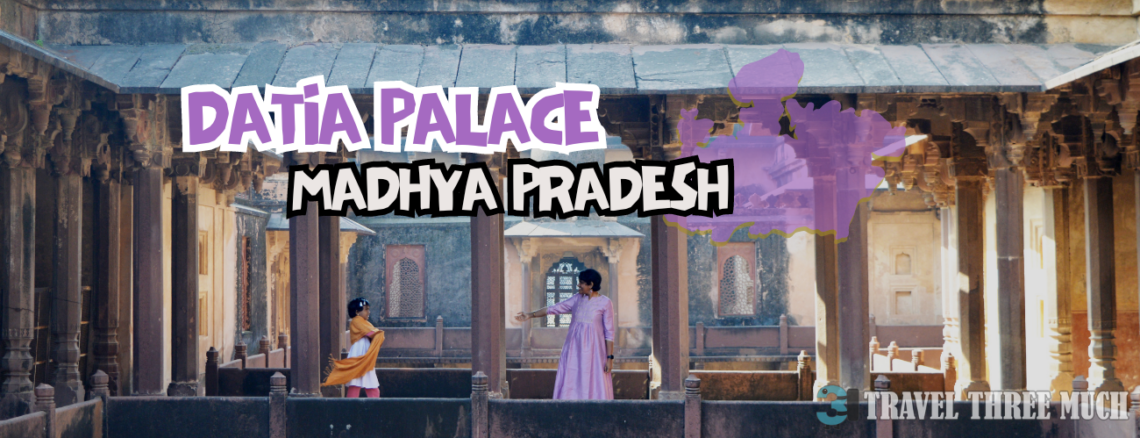
Datia Palace – An Ode to Friendship
Datia Palace was built by Raja Vir Singh Deo (Bir Singh in Bundela) from 1614 CE to 1623 CE.
 Plan your trip
Plan your trip
- Construction date: 1614 CE to 1623 CE
- Timings: 10:00 AM to 6:00 PM, open on all days
- Entry fee: INR 20 per person for Indian, SAARC and BIMSTEC citizens (free for children) and INR 250 per person for other citizens
- Getting there: Cab (50 km from Orchha)
- Note:
- The roads to the palace are through narrow bylanes and there is very limited parking. If you plan to drive on your own, consider these limitations.
- It is possible to book tickets online here. You can consider this option if worried about currency/mobile network availability at the fort.
Getting there
We took a cab from Orchha to Datia, about an hour’s drive away. Our driver assumed we were on a pilgrimage to Datia and took us straight away to a temple. Expecting a palace to be our destination, we shared a few confused looks when our driver announced we’d reached our stop. When we explained that we wanted to visit the Datia palace, he didn’t know which palace we were talking about. We showed him the route on Google Maps, but the last stretch couldn’t have been navigated without directions from the locals.
The palace is on an outcrop overlooking a lake on one side. The looming palace was visible long before we reached it.

History of the palace of Datia
The series of events which led to the construction of this palace is a fascinating piece of Indian history. Vir Singh was a jagirdar (landlord) in the eyes of the Mughal Empire. He tried to challenge the Mughals’ authority in his region. Meanwhile, Emperor Akbar tried to dissuade Prince Salim (later Emperor Jehangir) from pursuing Anarkali. Depending on the legends, Anarkali was either a royal courtesan or one of Akbar’s queens. When threats of disowning the prince proved ineffective, the emperor had her immured in a wall in his palace to end this dalliance. Heartbroken, Prince Salim rebelled against Emperor Akbar.
Vir Singh saw an ally in the prince and offered to assassinate a noble, Abu Fazal, whom Akbar had tasked with bringing Salim to heel at Agra. True to his word, Vir Singh had Abu Fazal assassinated and presented his head as proof to Salim. While Vir Singh earned Salim’s everlasting friendship and trust, he also incurred the emperor’s wrath. Forced on the run to avoid either being taken prisoner or worse, Vir Singh relied on Salim’s help for survival. Salim informed Vir Singh of the emperor’s plans and Vir Singh successfully evaded capture until Akbar passed away. Salim then ascended the throne as Emperor Jehangir. Vir Singh received a royal pardon and the entirety of Bundelkhand in return for his loyalty and support to Salim.
A quote by Salim (later Jehangir) from Jehangir Nama also confirms this narrative, “I employed the man who killed Abul Fazl and brought his head to me and for this it was that I incurred my father’s deep displeasure.”
Here is the stone telling you the architectural significance of this stunning palace built by Bir Singh Deo.

As you can see here, this palace has the elements of Rajput as well as Mughal architectural elements fused together. The reason for this could also be because Bir Singh Deo was a Rajput chief while it was built for Jehangir who was a Mughal emperor.
Many years later, Jehangir expressed his wish to visit Orchha. Vir Singh commissioned 52 buildings to honour and welcome his friend. One of these buildings is the Datia Palace, built to serve as a pit stop for the emperor’s entourage on their way to Orchha!
The palace is known by many names locally such as Govind Mahal, Govind Mandir, Jahangir Mahal, Satkhanda Palace, Purana Mahal, Bir Singh Mahal, Bir Singh Palace, Nrising Dev Palace, etc. If the locals don’t recognise one name, you can try another name, if you need directions.
Read our experience while visiting Orchha here.
The Palace Architecture
The entrance
A short trek from the parking took us to the ticket counter. A short flight of stairs led to the palace’s impressive entrance. The palace is an excellent example of the fusion of Rajput and Indo-Islamic schools of architecture. Edward Lutyens, the architect of New Delhi was so enamoured by the Datia Palace that he called it the most interesting building in all of India.

It is not a hyperbole. Structurally, the towering seven-storeyed palace uses no wood or iron and is entirely constructed from stonemasonry, stucco and rocks. Aesthetically, we got a glimpse of the workmanship on display at the massive entrance. Intricate designs and paintings above the entrance arch of horses and riders, various nobles of the court, floral motifs and gods were executed in what must’ve been vibrant natural hues. Stuccoed images of elephants with their riders in high niches on the sides of the entrance welcomed us in.
The soaring central tower and the causeways connecting it to the surrounding passages caught our eye at the entrance. A stone tablet informed visitors of the origins of the fort and its architectural features.
Onwards and Upwards
The first two levels we ascended were a bit underwhelming. Solitary lamps or weakly filtering sunlight battled overwhelming darkness in the flights of stairs and rooms. The only saving grace seemed to be the absence of bats and their ‘delightful’ smell!
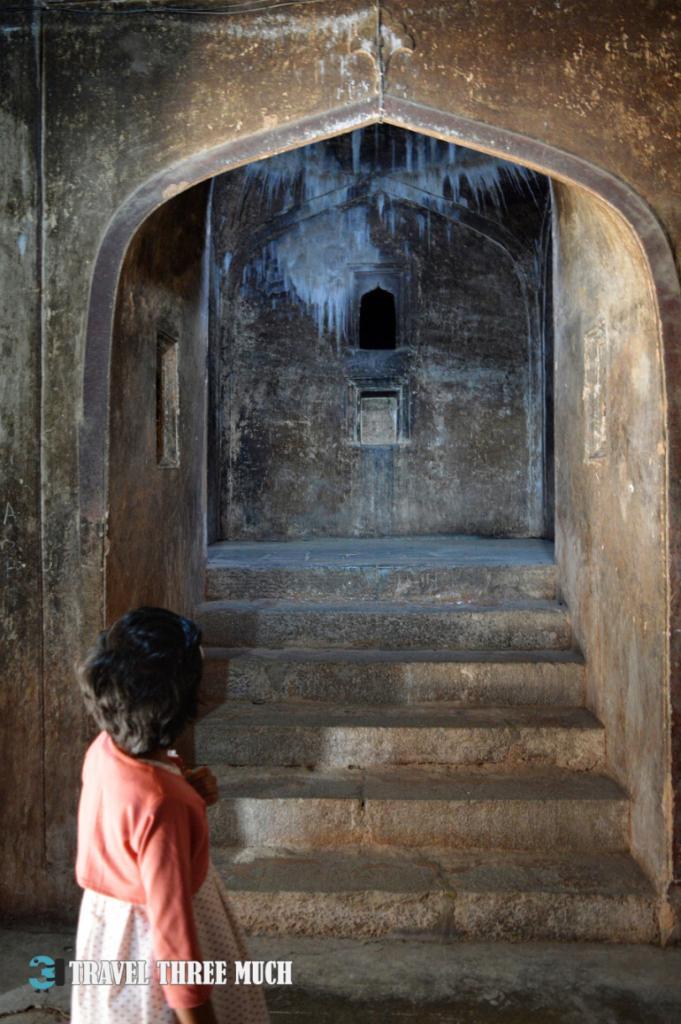
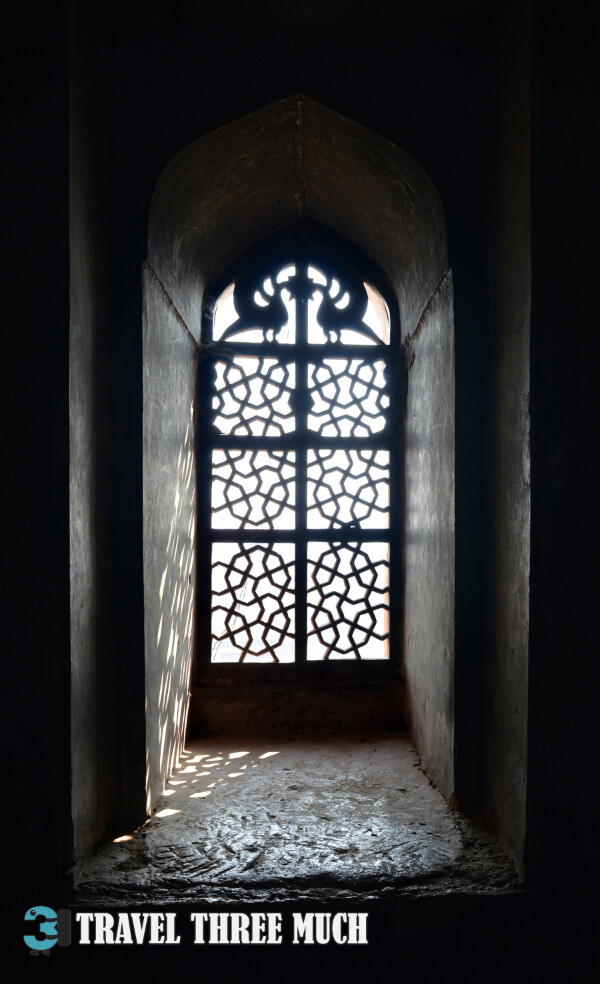
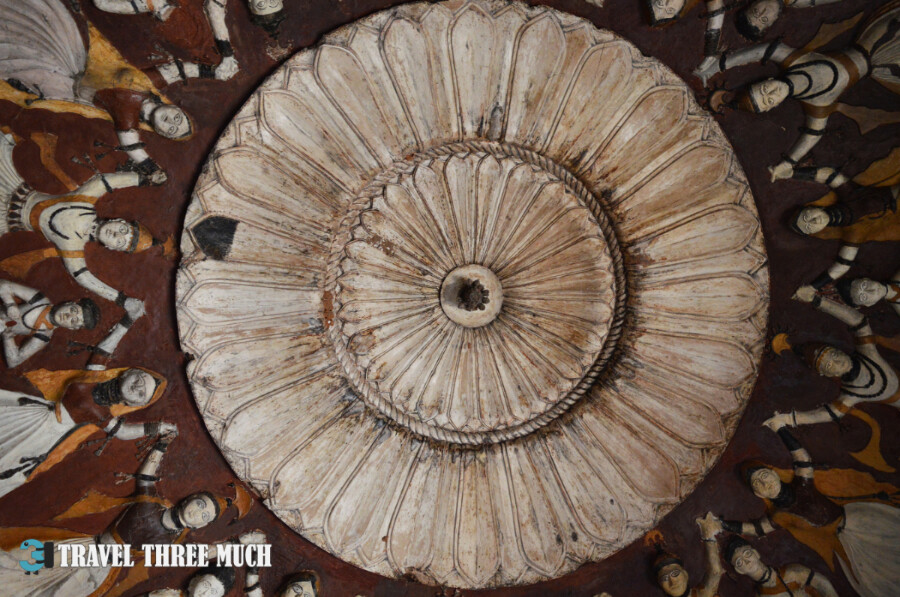
As our eyes adjusted to the dimly lit surroundings, the subtle art in the jaalis (stone lattices), arched corners and hints of frescoes on the ceilings emerged from the darkness. We saw a glimpse of the Datia town and another nearby ruin (which we didn’t explore) from one of the levels.
We stepped into the brightly lit central courtyard and immediately realised the hour-long journey was worth it! The majestic triple-arched entranceways to the courtyard sections each supported two more levels above them. Beautiful brackets supported the roof eaves extending out from the vertical walls. The uppermost level supported its roof on graceful pillars. The morning sun painted the entire structure in rich hues of ochres, browns and pinks.



Bundelkhand’s Other Hidden Gem
Datia proved that Orchha is not the only hidden gem of Bundelkhand. The walls of this level had richly detailed frescoes painted from natural dyes. The ravages of time and the lack of upkeep have taken a heavy toll on these ornate paintings. Yet, a mere hint of the famed turquoise, teal and orange hues on the ceiling is enough to make the mind leap to the impressive sight that the palace must’ve been when new.
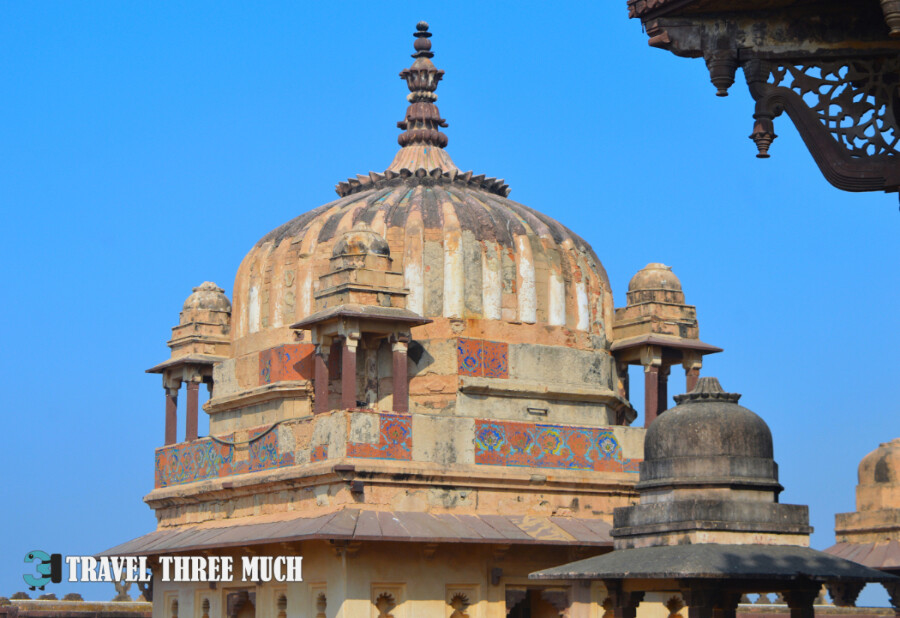
Ceilings
Paintings, stucco work and carvings befitting the royal visitors adorn the palace ceilings! ASI has renovated some of these paintings, maintaining the authenticity of the colours. The result – some of these richly detailed ceiling frescoes resemble Persian carpets.

Pillars, corridors and jaalis
Wandering about, we reached the upper levels of the courtyard complex. Perfectly symmetric pillars supported the roofs. The gentle sunlight was playing hide and seek with the shadows between the pillars. It was delightful to see the ever-changing hues as we meandered about in the corridors of the palace.
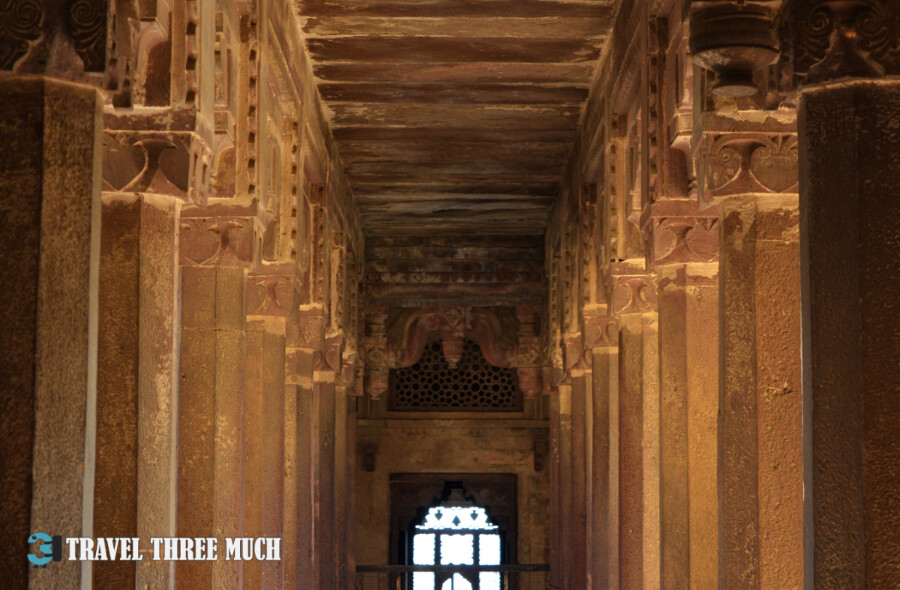
Nearly every window was covered by a jaali. The jaalis were carved lattices of stone and many were in excellent shape. They are a testament to the high levels of artistry achieved under the Bundela Rajputs’ patronage.


Musings and meanderings
It was somewhat tragic that a magnificent structure like this never served as a royal residence and even the intended royal visitors supposedly didn’t stop over for more than one night.
Jehangir had annexed the Fort of Kangra in Punjab in 1623 CE. This was also the year in which the construction of this palace was completed. This was a very difficult battle as his father Akbar had unsuccessfully tried to capture Kangra in 1615 CE.
Since Vir Singh had meant for the palace to be at Jehangir’s disposal, none of the Datia State’s royal family took up residence there even after Jehangir’s entourage supposedly stopped over for one night at this palace. The palace is deserving of so much more upkeep than what’s done today.
My spouse and I discuss at the end of every trip, the destination which made the most impact on us. For us, Datia Palace was the highlight of our trip to this part of Bundelkhand.

A Note of Thanks – We enjoy reading the works of George Michell and have a collection of most of his books. It is from one of his books –, The Royal Palaces of India, that we came to know about this gem of a place. (This is not an affiliate link!!) Anyone who loves heritage or architecture should check out the contributions of George Michell on this subject.


